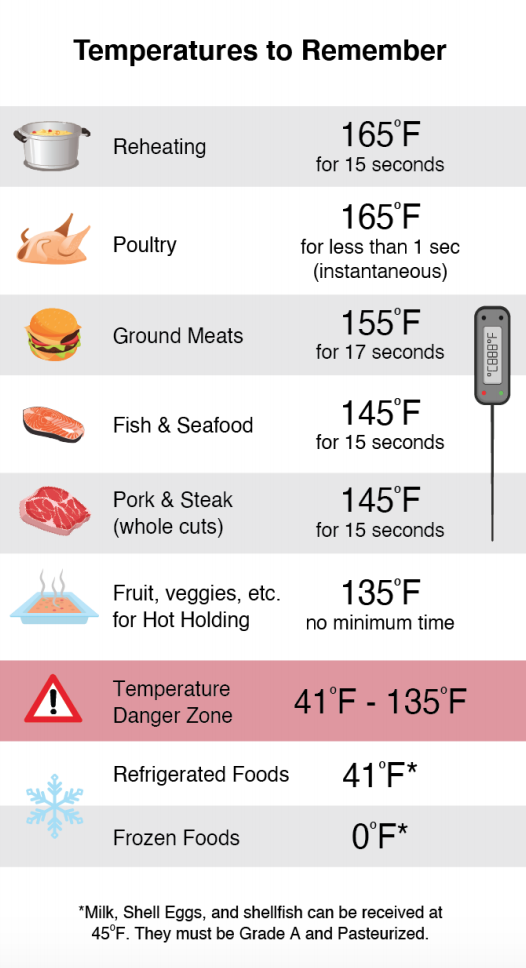Buffet Service Standards
Running a buffet poses certain food safety risks that you must manage to protect your customers from food poisoning. Buffets often include displays of hot and cold food, as well as a food held at room temperature; many of these foods (e.g. seafood, meat, dairy products) can harbor dangerous bacteria that can multiply rapidly in the right conditions, and customers themselves can often contaminate food without realizing it.
5 Rules for Buffet Food Safety
Follow these five rules to prevent food poisoning or allergic reactions from happening in your buffet-style restaurant.
To prevent a serious food safety incident from happening in your buffet-style restaurant, follow the five rules below:
1. Keep food out of the Temperature Danger Zone
All potentially hazardous foods (also called high-risk foods) must be displayed in hot or cold displays outside of the Temperature Danger Zone (4°C to 60°C*), which is the temperature range in which bacteria and other dangerous microorganisms can multiply rapidly.
High-risk foods include the following (and any dish containing the following):
meat/poultry/fish/shellfish
eggs/egg products
dairy products
leafy greens and other produce
For food items being held in the hot food zone, remember to:
stir items frequently to evenly distribute heat throughout the food
check food temperatures often
use a cleaned and sanitized thermometer to check food temperatures
calibrate your thermometer before use
If you’re using a probe thermometer to check hot food temperatures, insert the thermometer into the thickest part of the food (avoid bones and do not touch the thermometer to the sides or bottom of the display dish). For cold food items, if you are unable to stir the product, simply insert the thermometer into the thickest part to take an accurate reading.
Use labels or another system to indicate how long food has been on display, and when the last temperature check was performed; you can use any system that works for you, as long as it effectively communicates this information to all food service employees on duty, who can take corrective action if required.
If you must hold food at room temperature, be sure to discard any high-risk foods that have been on display for two hours or longer. To reduce food waste, you’ll want to prepare and display food in small batches that can be used within a two-hour timeframe.
2. Supervise and monitor self-service areas
The funny thing about buffet food safety is that the customers themselves often pose the greatest risk — to themselves and to other customers. On the other hand, Food Handlers are trained in proper food handling practices; many have completed a food handling course and obtained a food handling certificate from a recognized provider.
Food Handlers take precautions to prevent food contamination, whereas the public, who have not undergone food safety training, may not. That means that any man, woman, or child eating at the buffet could contaminate their own food and everybody else’s.
To save the customer from him or herself, it’s important that you supervise and monitor self-service areas. Allocate at least one staff member per shift (or per station) to supervise the buffet and train them on the steps to take if they notice a possible contamination incident.
It can be challenging to maintain careful supervision without making customers feel uncomfortable, so you’ll want to allocate these tasks to staff members with good customer service skills, who won’t be too intrusive.
We also recommend putting out signs to remind customers to:
use only the utensils provided for each food item
not use their fingers to touch any food items (“Please use the tongs provided.”)
use clean plates, cutlery, and napkins when they revisit the buffet for refills
supervise children who are serving themselves at the buffet
You don’t want customers to feel like they are under a microscope, but signage can help to remind customers that their actions can impact the health and safety of others. They will likely appreciate your efforts to minimize contamination risks — after all, who knows if the person standing next to them in line washed their hands properly?
3. Have at least one serving utensil for every food item
Using the same serving utensils for different foods, or touching food items with your bare hands, can cause cross-contamination; in a food setting, cross-contamination refers to the accidental transfer of contaminants to food, making it unsafe to eat.
In a full-service restaurant or other food business, cross-contamination is controlled by trained Food Handlers like chefs, cooks, and servers, who follow food safety protocols — such as using different utensils for different types of food — to minimize the risk of cross-contamination.
In a buffet-style restaurant, when customers use the same serving utensil to pick up different foods, or when they use their hands to pick up food items, they can:
introduce food allergens into dishes that should not contain them
transfer bacteria from raw food (e.g. sushi, sashimi) to ready-to-eat food (e.g. bread, cakes, pastries)
transfer bacteria or viruses from their hands to food
Having one or more serving utensils for each food item discourages customers from using the same serving utensil (or their fingers) to pick up different food items.
It’s important to stay on top of this; have cleaned and sanitized utensils ready to replace those in need of cleaning so that the food item is never left without a serving utensil. Even a short delay could result in a customer “winging it” with whatever is close at hand.
Remove any food or utensils that you notice have become contaminated from service and replenish them with fresh items.
4. If in doubt, throw it out
Food safety isn’t an exact science; foods that are contaminated with harmful bacteria and other pathogenic microorganisms (e.g. viruses, parasites) may not look, taste or smell any different from foods that are safe to eat. Trace amounts of food allergens are also tasteless and impossible to detect with the senses.
So how do you know for sure if food is safe to eat or if it needs to be thrown out? The short answer is you don’t always know. You can’t always tell if food is safe or not, which is why it’s important to understand the fundamentals of safe food handling and to follow food safety best practices.
For example, it's a best practice to throw away any high-risk foods from a buffet or self-service facility that haven't been used within two hours; this is because bacteria and other pathogens will have had time to multiply to unsafe numbers.
Remember that hot holding equipment is not designed to reheat food or to bring it to temperatures above 165°F, which is necessary to destroy harmful bacteria.
5. Take practical steps for food safety
While there are many potential sources of contamination in a buffet, there are several practical steps that can be taken to protect food and utensils from contamination.
For example:
Cover all food items with lids (whenever possible).
Use sneeze guards over buffet areas to prevent bacteria from sneezing or saliva from reaching the food.
Ensure that the handles of serving utensils don't touch food items, as bacteria from customers’ hands can get into it.
Keep raw food that will be used for cook-to-order items well away from pre-prepared or cooked foods.
Never add fresh food to old batches of food.
Never reuse food that has been sitting on a buffet table (even if it’s only been there a short time).
Keep cutlery and napkins under cover or well away from the food.
Clean and sanitize food trays frequently.
Ultimately, the best way to manage food safety hazards in your business is by training your food service employees. When Food Handlers understand why food safety is important, how to handle food safely, and how to prevent foodborne illness and other health risks, your customers (and your business) will benefit.
For how long can I safely hold food on a steam table?
Here it’s important to distinguish between how long you can hot-hold food and how long you should hold it. Under the food code, there is no set time limit for how long a food can be held, provided it maintains its temperature above the danger zone.
But just because something is safe to eat does not mean it should be eaten. Some foods, such as chili, for example, do well in hot-holding and may even be enhanced as flavors meld and some water evaporates over a period of a couple of hours. Other foods such as vegetables, eggs, fish, or baked items such as pancakes do not age well in a hot-holding environment.
Ideally, each item on your buffet or hot-held in the kitchen will have an established time limit as part of your standard operating procedures, considering not only the safety of the item but also its quality. Small digital timers can help you remember to refresh each item as it nears the end of its optimal life.
As a best practice for quality, safety, and waste reduction, prepare steam table items in smaller batches as needed rather than loading up the table and letting things devolve over a long period.
Steam tables vary widely in their settings. Some have words like low-medium-high, some have ranges of 1 (low) to 10 (high), while others may be 1 to 7. Some steam tables have the actual temperature settings.
The key question is not what setting you are using for your table, but what is the temperature of the food you are holding? Typically, hot food needs to be held above 135° F (exact temperatures may vary by county). The key is to use a good thermometer to frequently take the temperature of the hot-held food and adjust the steam table accordingly. In addition, you need to stir frequently to distribute the heat and take readings at the top edge of the held food, rather than the bottom, which is closest to the heat source. If the extra moisture would not affect quality, using a lid on the steam table can help with even, safe temperatures.
Holding above the minimum temperature is fine as well, but then you have to consider product quality issues. Some foods like broth-based soups hold well on the maximum setting. Others, like food containing eggs, you’ll want to hold closer to the minimum allowable.

